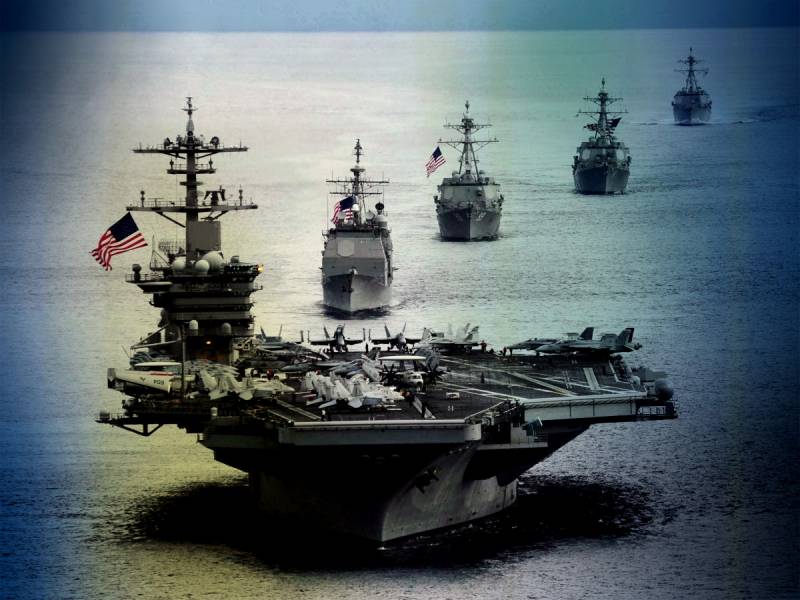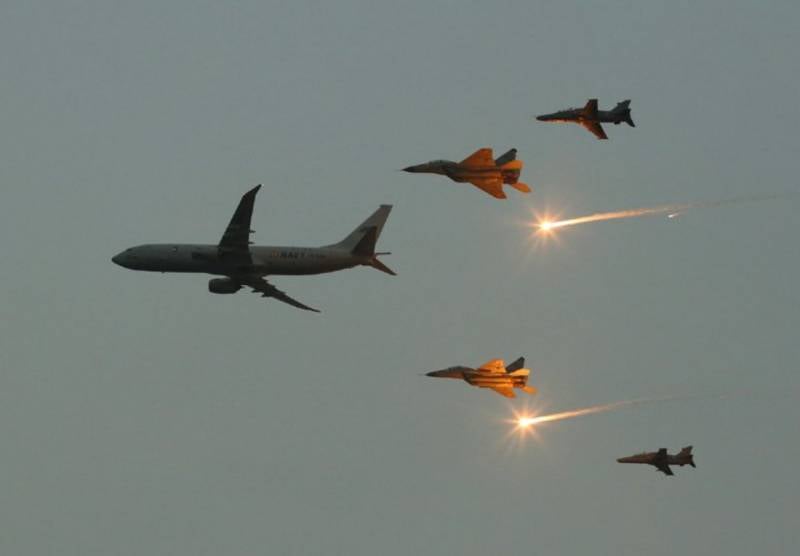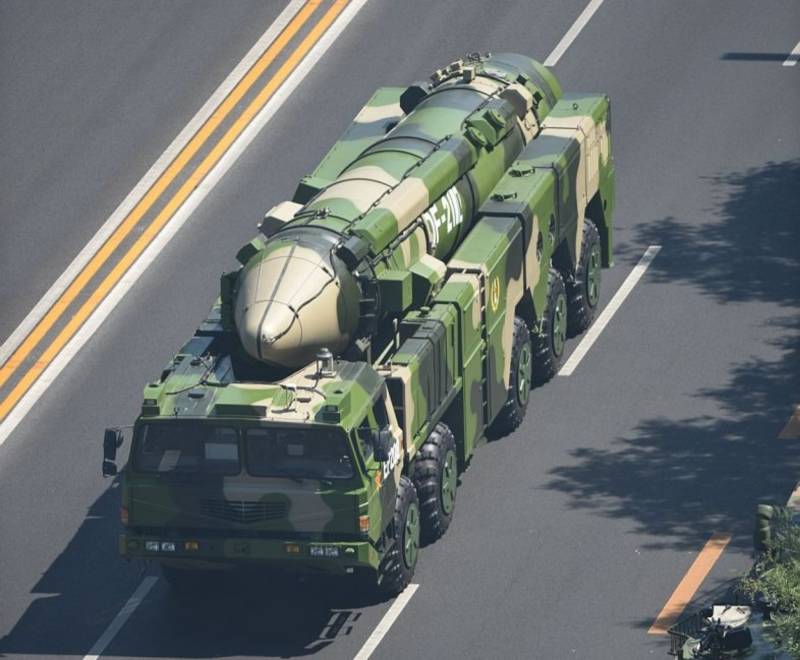"NATO-3": what consequences for Moscow and Beijing will the birth of a new geostrategic "pole" the "USA-India" entail?
While the majority of the informed population of the planet continues with great interest and parallel fear to monitor each news a report coming from the western part of the Asia-Pacific region, where a belligerent skirmish between the Pentagon and the U.S. administration, which they have imagined a lot about themselves, and adequately responding to threats by the DPRK leadership, can, on the other hand, develop into a full-fledged regional conflict using strategic weapons, no less important, from a global point of view, events are coming in South and Southeast Asia. Here, Washington is hastily trying to engage as many “links” in the chain of operational-strategic domination over the entire Indo-Asian-Pacific region. If earlier such states, Japan, Australia, South Korea and Taiwan were considered these “links”, today Vietnam and India are beginning to play a far from secondary role in this list. The leadership of the first strives with all its might to maintain control over its sectors of the island archipelago of Spratly and the Paracel Islands, located within the strategically important "9-dotted line" for Beijing, and the White House successfully uses Hanoi's regional ambitions to implement its operational-strategic plan for wedging ship drums Pacific factions fleet US to the near defensive line of the Chinese zone "A2 / AD".
Not only is there a systematic violation of the territorial waters of the People’s Republic of China in the area of the above archipelagoes by American Aegis destroyers of the Arleigh Burke class URO (their radar AN / SPY-1D (V) and DER sensors in the AN / SLQ-32 complexes allow you to get mass valuable information on the radar profiles of the new J-16, J-10B, etc.), the military leadership of Vietnam in the person of Ngon Suan Lity also gave the go-ahead to call at one of the Vietnamese ports of the American nuclear aircraft carrier next year. This event will lead to a final aggravation of relations undermined between Beijing and Hanoi. Recall that in order to drag Vietnam into an “anti-Chinese game”, it was announced in 2016 that the United States lifted the arms embargo, which quickly turned the corrupt government of the country into the Indochina “bedding” of Washington. Similar geopolitical metamorphoses are observed around India, but this is a completely different stage of the “Big Game”, the stakes on which are hundreds of times higher than in the case of small Vietnam.
The most significant recent event was the establishment of the so-called American-Indian Strategic Partnership Forum (USISPF), which, according to PRNewswire, is a non-profit corporation to accelerate the pace of interaction between states in the most knowledge-intensive and strategically important sectors of the economy, including the defense sector. The first beginnings of such a “partnership” began in 2004, when the details of the joint statement of the then US President George W. Bush and Indian Prime Minister Manmohan Singh after the meeting in New York became known. The main point of the statement was also the strengthening of military-technical cooperation. But then neither Washington nor Delhi considered a new level of partnership under the prism of countering the regional ambitions of the Middle Kingdom, because a year earlier, during the visit of Indian Prime Minister Atal Bihari to the Chinese capital and negotiations with Premier of the PRC Wen Jiabao, a new stage of development was announced Sino-Indian relations, built not on the same bellicose rhetoric, but on the construct. Meanwhile, over the next 14 years that have passed since the meeting of the Indian and Chinese prime ministers, a lot has changed dramatically.
First, in recent years, the Malabar bilateral Indian-American naval exercises (starting with 1992, they were conducted only by the Indian Navy) acquired a pronounced anti-Chinese character: Japan, Australia and Singapore Naval Forces were involved in them. Moreover, the long-standing Indian-Chinese territorial dispute about the ownership of the state of Arunachal Pradesh, as well as about the ownership of certain sections of the Indian-Chinese and Chinese-Bhutan high-mountain border near the Doka-La pass, located in the vicinity of the Indian state of Sikkim, periodically made itself felt. In the last days of June, 2017, a number of armed provocations took place here, during which the border troops of the PR of the People's Republic of China and India built defensive orders against each other, while Beijing threatened to escalate with large-scale escalation. Despite the fact that the Doca-La plateau is not directly related to the state of Sikkim and comes into contact with Bhutan, Delhi keeps this sector in the category of strategically important. Plays a role and the fact that Bhutan is the main ally of India. Of great importance is the fact that the pass is located in the immediate vicinity of the 23-kilometer tactical "corridor" in the area of the city of Goshpeker. It provides direct transportation between the mainland of India and the northeastern states of Meghalaya, Tripura, Manipur, Nagaland and Assam. The reason for the armed provocations was only the fact that the Chinese builders began to build a highway near the Doc-La plateau and at the same time violated the Sino-Indian border.
Such statements are like another marasmic history from Indian hotheads, regularly “heated” directly from Washington. If you carefully read the map of Bhutan, you can clearly see that the Doka-La plateau is located in 22 km from the Sino-Indian border, and the builders from the Middle Kingdom a priori could not break the border line. At the same time, Delhi preferred to further escalate the situation, pulling the Indian military contingent of several thousand troops to the plateau. Beijing responded asymmetrically. And what is most interesting, just a few days before the local escalation incident near Doc-La, the United States magazine The Strategist published a short analytical note in which, without weighty evidence, it is stated that the units of the People’s Liberation Army of China penetrate on a daily basis Indian territory and occupy its every square meter. It also indicates that over the past 10 years, India has lost around 2000 square. km of its territory. At the end of the article sounds a kind of guide to action for the command of the Indian Armed Forces, according to which Delhi is time to "show your own teeth." All the above confirms our assumptions about external sources of destabilization of the situation on the Indian-Chinese border.
The leadership of the Celestial Empire has long made it clear that it is not going to close its eyes to fomenting “destabilization centers” near its own border, fueled by powerful Western economies, and focused on supporting the defensive and strike potentials of the Pakistan armed forces. Islamabad also enlisted Chinese support for a territorial dispute over the state of Jammu and Kashmir (this conflict has been smoldering for 70 years). The most significant event in recent months was the sale of 9 to Pakistan by the HQ-16 “Red Flag” anti-aircraft missile systems, which are capable of withstanding the numerous air attacks of the Indian Air Force. An important technological aspect of the complex is the use of the TY-80 missile defense system, which, even in its standard version, is characterized by the presence of a gas-jet control system, represented by heat-resistant rotary planes in the nozzle solid propellant rocket motor. Due to this, at the time of the engine operation (in the upper part of the trajectory), the rocket is able to realize overloads of more than 35 units. This suggests that the HQ-9 divisions are quite capable of intercepting even modern tactical versions of the BrahMos family of anti-ship missiles in 20 - 40% of cases. The interceptor missiles of the HQ-16A complex have a range of up to 45 km and a target height in the 18000 m; at distances 15 - 20 km ballistic objects can be destroyed.
Moreover, when faced with HQ-16A complexes, the existing tactical aviation Indian Air Force will not have noticeable advantages in terms of electronic countermeasures, because the basis of the complexes are noise-protected multi-function radars with a passive phased array antenna with an instrumental range of about 85 km. MRLS has a great structural similarity to the 30N6E type illumination and guidance radar (on-board radar), but has less bandwidth (6 targets in the “track / SNP” mode and 4 targets in the “accurate auto tracking / capture” mode). Beijing’s no less serious step in support of Pakistan’s defense strategy is participation in the joint production and modernization line of the JF-17 Thunder fighter tactical fighter aircraft block I / II / III. At the moment, these magnificent 4 + / ++ transition generation vehicles are on the same technological level as the most advanced creation of Indian engineering (with French roots) - the Tejas Mk I / III multi-purpose tactical fighters. In the foreseeable future, modifications to the JF-17 Block II / III may be ahead of the Indian Tejas in such decisive parameters as EPR, the performance and range of the airborne radar, as well as the range of guided air combat missiles.
In particular, the “stela” variant JF-17 Block III can get a radically different airframe design with expanded use of composite materials, longitudinal ribs in the forward fuselage, a rectangular section of air intakes and 35-degree vertical tail tail collapse; the calculated EPR of this design can be no more than 0,6 - 0,7 м2 (without arms on hangers). As for the standard modifications of Block II / III, here the radar signature will remain at the same level of 1,5 - 2 м2, but the onboard defense complex and the radar complex will be upgraded; they also plan to install combined optical-electronic sighting systems on the machines that have similarities with our OLS-UEM (detection and capture of a VC in TV / IR channels of sight).
As for the new airborne radar, promising Chinese radars with active KLJ-7A phased array claim for their role, the range of operation, noise immunity and the list of operating modes are approximately between FGA-29 and AN / APG-63 (V) 3. In the case of the Pakistani Air Force's transmission of Chinese long-range air combat missiles PL-12D / 15 / 21D with integral rocket-ramjet engines (range around 200 - 250 km and acceleration at the final leg of the flight), even the numerical superiority of the fighter aircraft of the Indian Air Force will not allow Delhi to fly fast and unconditional victory over Islamabad. The best missile armament for ultra-long air combat, which is at the disposal of Indian pilots, is ASTR, MICA-IR / EM, R-27EP and RVV-AE. Their effective range barely reaches 90 - 120 km, and their speed parameters in the near-flight section of the trajectory rarely allow them to intercept an actively maneuvering enemy fighter, which cannot be said of the “long-range” air-to-air missiles.
We now turn to the July naval teachings "Malabar-2017". Unlike this series of exercises conducted in previous years, 17’s “Malabar” was noted with very important operational and strategic subtleties, which can only be interpreted as a demonstration of strength in front of Beijing. Firstly, in the above-water component of the US Navy, India and Japan, participating in the maneuvers were seen immediately 3 aircraft carriers - American nuclear aircraft carrier CVN-68 USS «Nimitz», Indian boiler and turbine aircraft carrier "Vikramaditya" and Japanese gas turbine destroyer-helicopter carrier "Izumo ". Secondly, the Indian version of the long-range anti-submarine aircraft P-8I "Neptune" of the Indian Navy, accompanied by two deck-based multipurpose MiG-29KUB fighter jets and two training aircraft Hawk Mk.132, "lit up" at the exercises in all its glory. Third, all this gigantic naval formation did not go anywhere, but to the eastern part of the Bay of Bengal, where the strategically important Malacca Strait begins. And it is extremely difficult to overestimate this importance, because it is through this strait that the Southern Sea Route passes, through which oil tankers from the Persian Gulf head for the Indo-Asia-Pacific region with valuable cargo of “black gold” on board. The version with obstruction of maritime transport between Southeast Asia and the Indian Ocean is the official protest note of the Chinese Ministry of Foreign Affairs, which responds to the recent naval exercises "Malabar-2017", while in reality the problem has a much more serious and unpleasant for Beijing, the background, which must be considered exclusively from a strategic point of view.
For example, in the event of an escalation of a major regional conflict with the participation of China and India, Delhi will undoubtedly receive broad-spectrum military support from the United States, Australia, Japan, and other pro-Western henchmen in the IATR. With 100% probability, it can be argued that, in addition to the Strait of Malacca, the Sunda Strait (between Sumatra and Java), as well as many small straits in the southern island chain of Indonesia will be closed. In fact, a long ocean zone “A2 / AD” (4500 km) will be formed, the southern tip of which will be located near the west coast of Australia, and the northern one in the area of the Andaman and Nicobar Islands. An interesting question may follow: is the strategy of building such a huge “A2 / AD barrier” in this sector of the Indian Ocean not utopian? Absolutely not. For proper control of all the above-mentioned straits for the passage of Chinese multipurpose nuclear submarines of the 093 Shan, and submarines of the same project upgraded to the B / G level, the 4-x destroyers of the Arley Burk-class URO and the pair of destroyers Hobart Class (AWD) - by the Royal Australian Navy. As an air component of anti-submarine defense, just a couple of long-range patrol aircraft of the P-8A / I type will suffice. The Australian Poseidon will monitor the southern submarine sectors of the A2 / AD zone (off the west coast of the islands of Java and Sumatra), while the Indian Netun will monitor the underwater conditions in the vicinity of the Bay of Bengal.
Nevertheless, there is such an option for the development of the operational-strategic situation, in accordance with which the shipboard attack group of the “anti-Chinese coalition” will have to leave the Andaman and Nicobar Islands area, moving closer to the southern Indian state of Tamil Nadu, since the PLA has a unique ballistic anti-ship to date medium-range rocket DF-21D, which has a range of 1800 - 2000 km and reaches the eastern part of the Bay of Bengal without any problems (when launched from Yunnan province). Even the classic American AUG with two "Ticonderogs" and three "Arles Burke" will not cope with a massive anti-ship strike from 40 - 50 BPKR DF-21D. However, shifting the northern “petals” of the “A2 / AD” zone towards India will secure the coalition ships, but control will no longer require the destroyer 2 - 3, but more 8, since the potentially dangerous direction will be represented no longer by a small Malacca Strait, and the whole Bay of Bengal.
In this scenario, multipurpose nuclear submarine cruisers and surface ships of the PRC Navy may remain blocked within the South China and Yavan Seas, which will not allow supporting the naval infrastructure on the new naval base in Djibouti, which will lead to the inevitable loss of the most important strategic object in the Gulf of Aden . To avoid such a result, China should focus as much as possible on the development and launch of mass production of promising low-profile medium-range H-20 bombers, as well as anti-ship ultra-long-range missiles, which can hit the enemy carrier strike order long before the enemy F / A fighter planes hit the lines of action. -18E / F and F-35C.
The latest troubling news was the recent statement by the commander of the Pacific Command of the US Armed Forces, Harry Harris, who pointed to the "fantastic possibilities and global significance of military cooperation" between Washington and Delhi in the 21st century. All this happens at a time when the Indian HAL is "rubbing its hands" in anticipation of an additional package of unique technologies from Sukhoi under the FGFA project, and the Indian army is getting into service the S-400 Triumph air defense systems ... It's time to stop distributing domestic technologies to the right and to the left ..
Information sources:
http://forum.militaryparitet.com/viewtopic.php?id=17900
http://bmpd.livejournal.com/2719454.html
http://www.rbc.ru/politics/09/08/2017/598857c79a794778be609b0b?from=center_5



Information